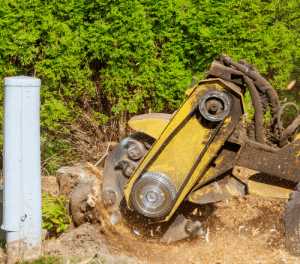So you’ve had a tree removed—but now there’s an ugly stump sticking out like a sore thumb in your yard. It’s not just unsightly, it’s also a tripping hazard, a haven for pests, and a pain when mowing. That’s where stump grinding comes in—it’s the final touch that truly clears the space and gives your lawn a polished, clean look.
The Difference Between Stump Removal and Stump Grinding
While stump removal involves digging out the entire stump and root system (a back-breaking job), stump grinding focuses on shredding the stump down to below ground level using specialized equipment. It’s faster, less invasive, and leaves your landscape intact.
What Is Stump Grinding?
Definition and Purpose
Stump grinding is the process of using a machine to chip away the tree stump and major roots left behind after tree removal. The goal is to grind the wood below the surface, usually 4 to 16 inches deep, so the area can be covered with soil or grass.
How the Process Works
A stump grinder uses a high-speed rotating blade with sharp teeth to turn the stump into mulch. Operators move the grinder in a side-to-side motion, slowly cutting away the wood. The result? A smooth, level surface ready for whatever’s next.
Benefits of Stump Grinding
Improves Curb Appeal
Let’s face it—tree stumps are not pretty. Removing them instantly upgrades the look of your yard, making it appear cleaner and well-maintained.
Prevents Pest Infestation
Rotting stumps attract termites, ants, beetles, and even rodents. Grinding the stump eliminates the environment these pests love.
Stops Tree Regrowth
Some tree species can sprout from stumps. Grinding them down to the roots helps prevent annoying new growth.
Makes Lawn Maintenance Easier
No more maneuvering the mower around obstacles or risking a damaged blade—grind the stump and reclaim that space.
Increases Safety
Stumps are trip hazards, especially for kids playing or when hidden by grass. Grinding removes that danger completely.
Stump Grinding vs. Stump Removal
Pros and Cons of Each Method
- Stump Grinding Pros: Less invasive, quicker, cheaper, minimal damage to yard
- Stump Grinding Cons: Roots remain underground
- Stump Removal Pros: Complete removal of stump and roots
- Stump Removal Cons: More expensive, involves heavy excavation
Which One Should You Choose?
If you don’t mind leaving roots behind and want fast results, go with grinding. If you’re planting in the same spot or dealing with invasive roots, full removal might be the better call.
The Stump Grinding Process
Step-by-Step Breakdown
- Inspect the area – Check for rocks, pipes, or other obstructions.
- Clear debris – Remove any surrounding sticks, branches, or brush.
- Position the grinder – Place it over the stump and start grinding.
- Grind in layers – Work side-to-side, going deeper with each pass.
- Clean up – Rake the wood chips, fill the hole if needed.
Equipment Used
Stump grinders come in various sizes:
- Handheld – Good for small stumps
- Walk-behind – Great for medium jobs
- Tracked or Tow-behind – Best for large or multiple stumps
Depth and Precision of Grinding
Most grinders can go 4–16 inches deep, depending on the machine and your landscaping goals.
DIY Stump Grinding vs. Hiring a Professional
When It’s Safe to DIY
Small stumps on flat, clear ground may be manageable with a rental grinder—if you’re confident using power tools.
Advantages of Professional Services
- Experience and safety
- Proper tools for any size stump
- Quicker and cleaner results
- Insured in case anything goes wrong
Cost Comparison
- DIY: $100–$300 for rental + transport + time
- Pro Services: $140–$400 per stump depending on size/location
How Much Does Stump Grinding Cost?
Factors That Affect Pricing
- Size and height of the stump
- Tree species (hardwoods take longer)
- Number of stumps
- Accessibility
- Local rates
Average Cost Ranges
- Small stumps: $75–$150
- Medium stumps: $150–$275
- Large stumps: $275–$400+
Bulk grinding discounts are often available.
What to Do After Stump Grinding
Filling the Hole
Use the leftover mulch to partially fill the hole, then top with soil to level the ground.
Replanting or Landscaping
Grow grass, plant flowers, or install garden features. The area is now ready for something new.
Using the Mulch
Don’t throw it away—stump grindings make excellent mulch for your garden or around trees.
Common Mistakes to Avoid
Grinding Too Shallow
If you don’t grind deep enough, roots may sprout, or the stump may remain visible.
Ignoring Nearby Utilities
Always call 811 before digging or grinding—hidden wires or pipes can be a serious hazard.
Not Cleaning Up Properly
Leaving grindings in a big pile can suffocate grass or plants. Spread it or remove excess mulch.
Environmental Considerations
Eco-Friendly Disposal of Grindings
You can compost or recycle wood chips. Avoid burning them unless permitted.
Sustainable Landscaping Ideas
After grinding, consider planting native plants or installing eco-friendly features like rain gardens or pollinator beds.
Conclusion
Stump grinding is a fast, affordable, and minimally invasive way to clear your yard of unwanted stumps. Whether you’re looking to make your yard safer, more attractive, or easier to maintain, this process is a smart move. Just make sure it’s done safely—either by you with care, or better yet, by a trusted professional.
FAQs
1. How long does stump grinding take?
Most stumps take 15–60 minutes to grind, depending on size and hardness.
2. Will the tree grow back after grinding?
Not usually. Proper grinding down to the roots stops regrowth in most species.
3. Is stump grinding safe for my yard?
Yes—if done properly. Just ensure no pipes or cables are nearby.
4. Can I rent a stump grinder?
Yes, most hardware stores rent grinders. Just be prepared to handle a heavy, powerful machine.
5. What happens to the roots after grinding?
They remain underground and will naturally decay over time.




























